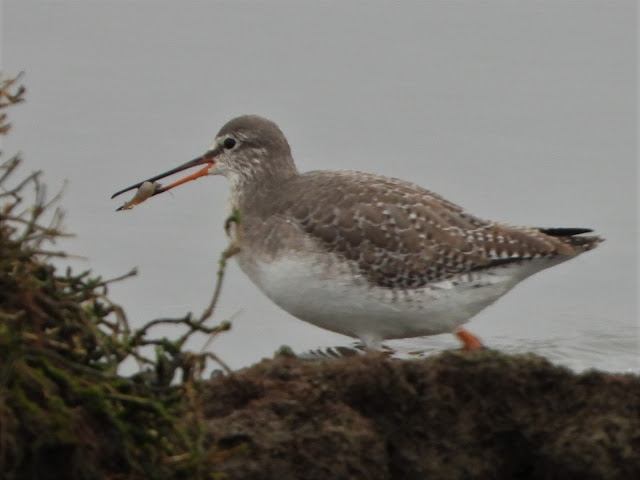Thorney Island Trip Report, Guided Birdwatching January 2022
January is a busy time at our wetlands, with overwintering birds in great abundance. On a trip to Thorney Island this was in evidence, with an interesting mix of species seen.
In the car park a chiffchaff was calling, a good start. Along the path towards the sea wall great tits displayed their wide repertoire of sounds, and long-tailed tits moved through the bushes. Before reaching the sea wall the brent geese were apparent by their regular chattering calls. Once there, the bare mud was studded with geese, ducks, and wading birds.
A number of dunlin, redshank and turnstones were being particularly obliging, picking through the seaweed just beyond the base of the wall. The short range made close study of these a joy. The birds, having been accustomed to people regularly walking along this section, fed in the mud unperturbed by a group of onlookers.
 |
| Dunlin |
On a freshwater area sat a nice selection of tufted ducks, with the occasional little grebe popping up to the surface before hurriedly disappearing back under.
 |
| Tufted Ducks |
A pale-looking wader dropped in behind some bushes at a surprising speed, an all too brief glimpse. Fortunately it appeared a short while later at close range, and was a nice surprise in the shape of a spotted redshank.
 |
| Spotted Redshank |
It busily fed while wading typically deeply, and also swam around on occasion. It seemed to have found a good foraging area.
 |
| Spotted Redshank |
Another pale wader put in an appearance, this time a greenshank. The area with the greenshank held an amazing number of coots, and remarkably we didn’t see any of them fighting with each other as they often love to do.
Further south on the island we came upon a whimbrel feeding amongst the seaweed. A nice bird to find in the middle of winter. There were some handy waders for size comparison purposes, an oystercatcher and a redshank, giving context to how much smaller a whimbrel is compared to the somewhat similar-looking curlew.
 |
| Whimbrel |
On the rising tide two red-breasted mergansers appeared. Following on from them, the similarly named, but differently looking, red-throated diver headed up the channel. Initially it was regularly diving to search for food, but eventually settled in a spot straight in front of us. After a while it rolled onto its back to preen its underside, lifting its large foot up to the sky. It’s always a treat to see a diver within the harbour.
 |
| Red-throated Diver |
On the walk back we stopped for lunch looking across the grasslands of Thorney Island. One area has clumps of gorse mixed in with the rough grasses. While eating lunch, a sparrowhawk discretely flashed between two gorse clumps. It then reappeared and flew very slowly while hugging the tops of the bushes, trying to catch some small bird off guard. Luckily it even landed in a bare rose bush for us to admire for a while.
 |
| Sparrowhawk |
After the sparrowhawk came a kestrel. It tried to land in a small tree amazingly close by, but decided this was a bit too much, and moved to perch only 10 or 15m further back. At this range its beautiful plumage could be admired, and its bright feet shone out despite the cloud overhead.
 |
| Kestrel |
Continuing our walk back three marsh harriers appeared, giving really nice views. A great way to end the outing.
If you are interested in attending a guided birdwatching session such as this one, the upcoming events can be seen on the ‘Events’ page of this website. Or to stand the best chance of a space being available, you can get the information emailed to you prior to its publication online by joining my mailing list. To do so simply email me at baggaleyhugh@gmail.com
Photos from this trip were taken and kindly provided by Les Phillips.
- Hugh Baggaley



Comments
Post a Comment